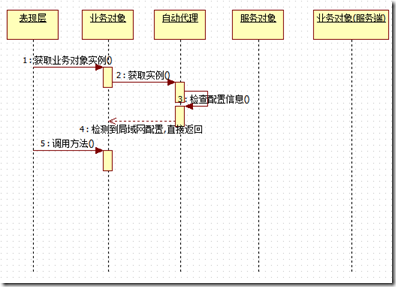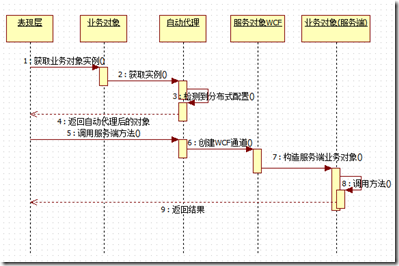我们在开篇中提到,希望能有一种办法,能自动适应系统的环境配置,在局域网小型应用中将直接访问数据库以获得最高的性能,在分布式环境中自动使用WCF来获得较好的安全性和连通性。
但是,我们不希望这样的特性使我们的开发变得过于复杂,需要在新特性和工作量之间寻求一个合理的平衡点。
原理分析:
用自动代理的业务层结构如下:

检测到局域网配置时的情况,将直接返回业务对象实例。

分布式配置的调用情况。
我们可以从图上看出,使用局域网配置或分布式配置完全取决于自动代理对象,而对于使用者(表现层)是完全透明的。当然,对于分布式配置的情况,传入业务端的参数和结果都是需要经过序列化的,否则将无法在WCF中传输,这是我们在开发业务层时需要注意的问题。
自动代理的对象实现很简单,我们需要做的就是拦截调用,将调用的信息(业务对象名,方法名,参数)等构建为WCF服务对象的参数,通过统一的服务接口调用服务端,服务端得到调用后,根据调用信息实例化合适的业务对象,调用相应的方法,完成后将结果以统一的返回格式返回给自动代理对象,而这些返回的数据将被反序列化后作为该方法的返回值。
代码实现:
在目前的开源框架中,Castle和Spring.net都提供了很好的自动代理的类库。我们将以Spring.net为例来实现自动代理对象。
public static class BizAutoWcfProxy {public static T Get<T>(T instance) where T : class{var p = new ProxyFactory(instance);p.AddAdvice(new AroundAdvise());return p.GetProxy() as T;}internal static IWcfProxy GetMethodProxy(){var service = PubFunc.GetAppSetting("WcfService");if (string.IsNullOrEmpty(service)){return new WcfProxy();}var binding = new NetTcpBinding(SecurityMode.None, false);var f = new ChannelFactory<IWcfProxy>(binding, service);var proxy = f.CreateChannel();return proxy;} }
上面是自动代理工厂的实现.这个工厂中,提供了一个供自动代理对象使用的方法GetMethodProxy,这个方法中检测应用程序配置文件的WcfService配置,如果配置不为空,则创建自动代理对象,否则直接返回.
public class AroundAdvise : IMethodInterceptor {public object Invoke(IMethodInvocation invocation){Log.Get().Debug("方法{0}被调用被拦截", invocation.Method.Name);try{var p = BizAutoWcfProxy.GetMethodProxy();//调用信息var m = new MethodProxy{ClassName = invocation.TargetType.AssemblyQualifiedName, //业务对象名MethodName = invocation.Method.Name //方法};//将调用参数也包含在调用信息中if (invocation.Arguments != null && invocation.Arguments.Length > 0)m.Params = invocation.Arguments.ToList().ConvertAll(PubFunc.Serialize.ObjToBytes).ToArray();//调用WCF服务var r = p.Execute(m);//正常的情况,没有异常出现if (!r.HasException){//返回值object returnValue = r.GetValue();var ind = 0;//处理ref和out的参数的返回invocation.Method.GetParameters().ToList().ForEach(mp =>{if (mp.IsOut){invocation.Arguments[mp.Position] = PubFunc.Serialize.BytesToObj(r.OutValue[ind++]);}});return returnValue;}//出现异常的情况,反序列号异常信息,重新在客户端抛出var ex = PubFunc.Serialize.BytesToObj(r.Exception) as Exception;if (ex != null) throw ex;throw new Exception("无法反序列化异常信息");}catch (CommunicationException oe){Log.Get().Debug("WCF通讯错误", oe);throw;}} }
上面是方法拦截的实现。这里除了需要考虑正常情况下调用之外,还要考虑服务器端可能发生的异常,这里增加了对异常的处理。
//唯一的WCF接口 [ServiceContract] public interface IWcfProxy {[OperationContract]ReturnValue Execute(MethodProxy m); } //服务实现 public class WcfProxy : IWcfProxy {public ReturnValue Execute(MethodProxy m){try{//服务端实例化业务对象var con = Type.GetType(m.ClassName).GetConstructor(BindingFlags.NonPublic| BindingFlags.Public| BindingFlags.Instance,null,new Type[0],null);var cls = con.Invoke(new object[0]);//处理参数的反序列化var method = cls.GetType().GetMethod(m.MethodName, BindingFlags.Instance | BindingFlags.Public);var pm = new object[0];if (m.Params != null && m.Params.Length > 0)pm = m.Params.ToList().ConvertAll(PubFunc.Serialize.BytesToObj).ToArray();//调用var rlt = method.Invoke(cls, pm);var r = new ReturnValue();r.SetValue(rlt);//处理out参数var outPlist = new List<byte[]>();method.GetParameters().ToList().ForEach(p =>{if(p.IsOut){outPlist.Add(PubFunc.Serialize.ObjToBytes(pm[p.Position]));}});if (outPlist.Count > 0)r.OutValue = outPlist.ToArray();//正常返回return r;}catch(TargetInvocationException ex1){var ex = ex1.InnerException;//处理服务器端发生的两种异常信息,这些属于正常的业务异常,需要返回到客户端if (ex is BizException || ex is DAException){var r = new ReturnValue();r.HasException = true;r.Exception = PubFunc.Serialize.ObjToBytes(ex);return r;}else{//非正常情况下的异常,统一包装为服务端异常返回var serverex = new ServerException(ex.Message);serverex.Trace = ex.StackTrace;var r = new ReturnValue();r.HasException = true;r.Exception = PubFunc.Serialize.ObjToBytes(serverex);return r;}}} } //服务返回对象 [DataContract] public class ReturnValue {[DataMember]public bool HasException { get; set; }[DataMember]public byte[] Exception { get; set; }[DataMember]public byte[] Value { get; set; }[DataMember]public byte[][] OutValue { get; set; }public void SetValue(object value){if (value == null){Value = null; return;}Value=PubFunc.Serialize.ObjToBytes(value);}public object GetValue(){if (Value == null){return null;}return PubFunc.Serialize.BytesToObj(Value);} } //调用信息 [DataContract] public class MethodProxy {[DataMember]public string ClassName { get; set; }[DataMember]public string MethodName { get; set; }[DataMember]public byte[][] Params{get;set;} }
这里是完整的服务端的方法,提供WCF接口,处理业务层对象调用的过程。
实现不算复杂,代码也不多,欢迎讨论。不足之处请指正。





)



_host与device)


![static_cast、dynamic_cast、reinterpret_cast、const_cast[转]](http://pic.xiahunao.cn/static_cast、dynamic_cast、reinterpret_cast、const_cast[转])


)
...)


